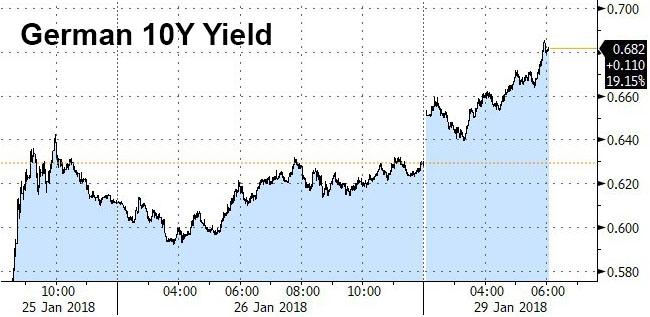The recent frantic moves in Treasury’s and the dollar continued on Monday as we enter what is set to be a juggernaut of a “rollercoaster week”, and while the dollar collapse seems to have slowed, for now, this is as a result of an acceleration in the Treasury selloff, with 10Y yields blowing out to 2.72% for the first time since early 2014, and now deep into what Jeff Gundlach called the “danger zone” for equities.

The TSY weakness is also hitting German Bunds, where the 10Y yield rose to 0.682%, the highest since 2015 and rapidly threatening another VaR shock should the selloff accelerate from here.

Also of notable: the German 5-year bond yield rose as much as 4bps from the open to turn positive for the first time since Dec. 2015, rising as high as 0.012% after ECB Governing Council member Klaas Knot over the weekend said there isn’t a single reason to continue with the QE program.

For once, the Greenback is a broad winner, if very modestly, as high/rising US Treasury yields, now at levels last seen in early 2014, are finally offering the USD some support after 7 weeks of losses, while month-end rebalancing is also prompting short-covering given buy signals and latest weekly CTFC spec positioning showing another increase in shorts. The DXY looks firmer above the 89.000 level, but really needs to extend recovery gains beyond 89.500 for a more sustained retracement and to prevent bears from further attacks on key supports below 88.500.

“The higher Treasury 10-year yield is spurring dollar-buying,” said Ko Haruki, head of the financial solutions group at CIBC World Markets (Japan) in Tokyo. “The dollar is consolidating with major currencies failing to break Thursday’s highs.”
Meanwhile, the yen fell after Kuroda’s comments on stronger inflation. GBP/USD slid as much as 0.5% to 1.4094 amid media reports that the Conservatives are poised to trigger a vote of no confidence in U.K. PM May.
The Swiss franc fell versus all G-10 peers amid speculation of possible Swiss National Bank intervention first spurred leveraged buying of USD/CHF, before sellers responded and pulled the pair back down; SNB declined to comment on the matter.
The euro weakened as German bonds retreated for a fourth day, while the Stoxx Europe 600 Index turned lower after benchmarks were mixed in the Asian session.
After trading mixed early in the session, European tech stocks retraced much of their earlier gains on Monday, as traders cited the previously noted report that Apple has cut production as much as 50% for the iPhone X. Nikkei Asian Review says Apple has alerted suppliers it has cut its production target for the flagship phone to 20 million units in Q1, from a previous estimate of 40 million envisaged in November. Apple suppliers Dialog Semiconductor DLGS.DE, STMicroelectronics STM.BN, Infineon IFXGn.DE, IQE IQE.L and AMS AMS.S all fade gains shortly after the report, though all five stocks remain up on the day after AMS reported results well ahead of expectations
In terms of sector specifics, material names outperform following price action in the metals complex with Rio Tinto, Anglo American, Glencore, Antofagasta and BHP all near the top of the FSTE 100. Elsewhere, focus has also been on the IT sector with AMS (+20%) and Wirecard (+1.7%) soaring in the wake of earnings. Other notable equity specific newsflow includes Sanofi acquiring Ablynx (+3.5%) for EUR 3.9bln and a double upgrade at BAML for Volkswagen (+1.5%) with BAML commenting on whether the Co. could be a potential break-up candidate.
Earlier, Asia-Pac bourses traded mixed: the ASX 200 (+0.4%) and Nikkei 225 (Unch.) opened positive with Australia buoyed by M&A activity including AWE shares which rose 16% on reports of a bid from Mitsui & Co., while Japan stocks were less decisive with price action dictated by currency moves and the stronger yen killed early upside equity momentum.
Notably, Chinese stocks slumped the most in 2 months as large caps retreated. Equities in Hong Kong also fell, while the big-cap CSI 300 Index loses 2% as of 2:49pm local time. Shanghai Composite Index closed down 1.3% while the Shenzhen Composite Index fell -1.7%. Some Chinese investors are closing their books before Chinese New Year, which means inflows to the stock markets will slow, said Frank Lee, acting chief investment officer for North Asia at DBS Bank (HK) Ltd.
Elsewhere, U.S. oil fell, though it’s at about its strongest level in five months relative to Brent as a weaker dollar and falling stockpiles boosted the American marker. Metals advanced amid optimism over global growth and the impact of the softer greenback, with zinc soaring to the highest level in more than a decade.
Bitcoin climbed, holding its value above $11,000 even after a heist of nearly $500 million in a different digital token spurred calls for more cryptocurrency regulation
Janet Yellen’s final policy meeting as Federal Reserve chair will be the main focus of investor attention in what’s shaping up to be another active week for markets still finding their feet after the recent dollar selloff. There’s a string of fresh economic data due, as well as a State of the Union address from President Donald Trump and earnings releases from the world’s biggest tech companies.
Bulletin Headline Summary from RanSquawk
Market Snapshot












Leave A Comment